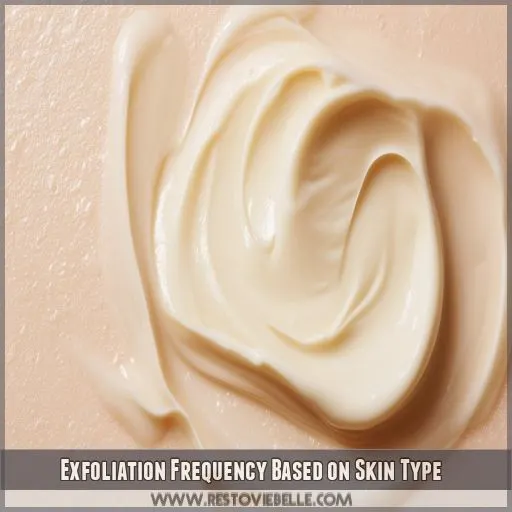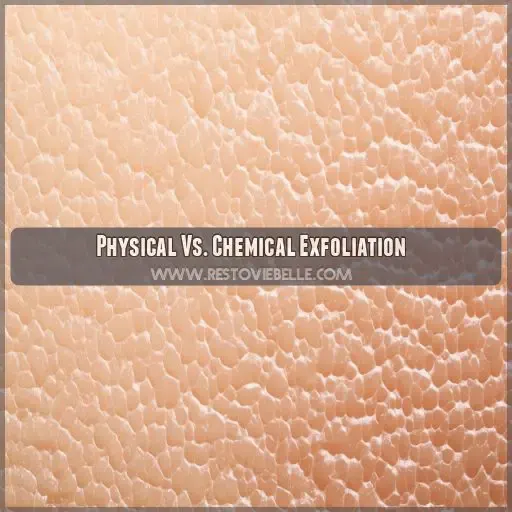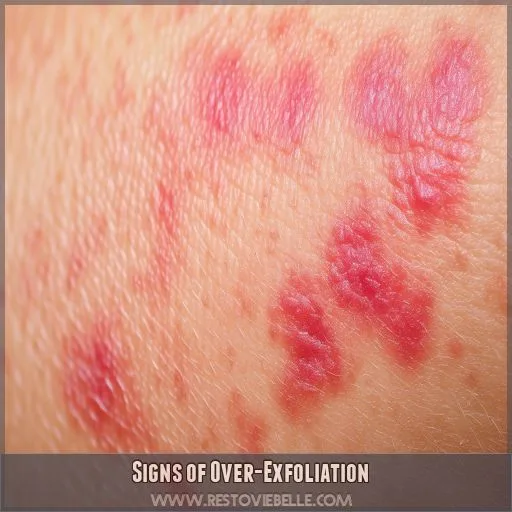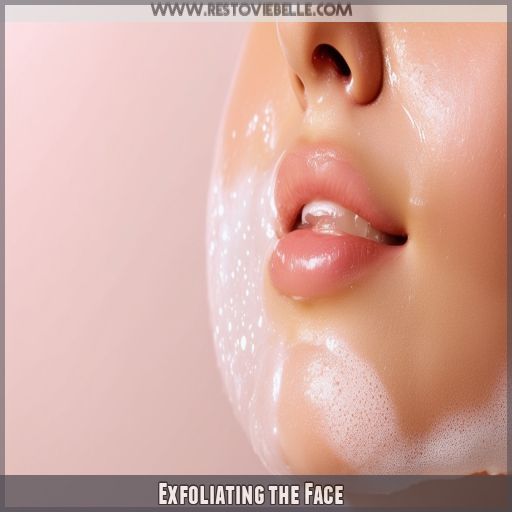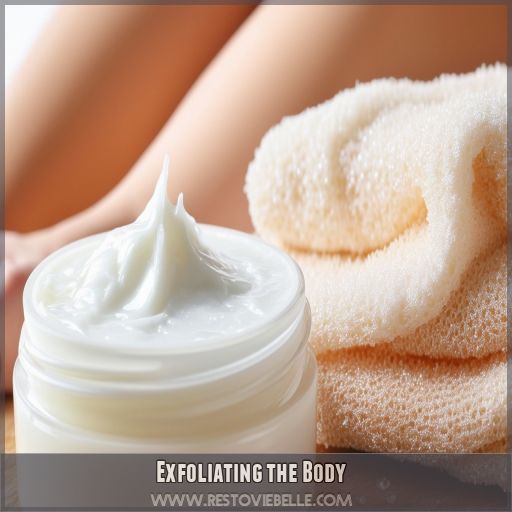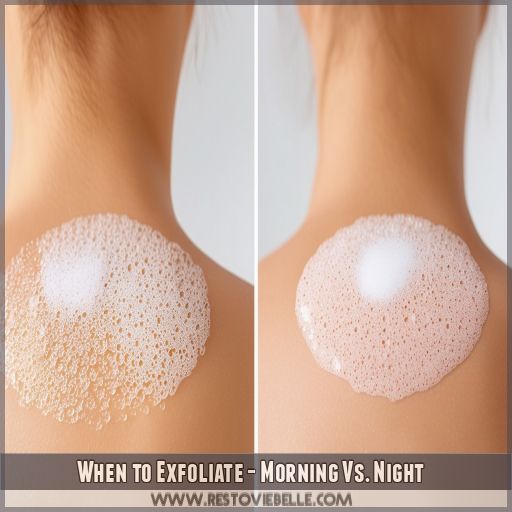This site is supported by our readers. We may earn a commission, at no cost to you, if you purchase through links.
 Get Rid of Dead Skin Cells: A Guide to Exfoliating Your Body
Get Rid of Dead Skin Cells: A Guide to Exfoliating Your Body
Exfoliating is a great way to remove dead skin cells and improve the texture and appearance of your skin. But how often should you exfoliate your body? This guide will help you understand the different methods of exfoliation, how frequently to do it, and the specific areas of your body that may need targeted exfoliation. You’ll also learn about the risks of over-exfoliation and the best time of day to exfoliate for satisfactory results.
Table Of Contents
- Key Takeaways
- How Often Should I Exfoliate Your Body?
- How Often Should You Exfoliate Your Body?
- Exfoliation Frequency Based on Skin Type
- Physical Vs. Chemical Exfoliation
- Signs of Over-Exfoliation
- Exfoliating the Face
- Exfoliating the Body
- Targeted Exfoliation for Different Body Parts
- Over-Exfoliation Risks and Precautions
- When to Exfoliate – Morning Vs. Night
- Pre-shower or Post-shower Exfoliation
- Frequently Asked Questions (FAQs)
- How often should you exfoliate?
- How often should one apply face mask for skin health?
- How often should you use exfoliating body Polish?
- How long should you wait to exfoliate your skin?
- Is it good to exfoliate body everyday?
- How often should you do a full body exfoliation?
- Should I exfoliate in the morning or night?
- Should I exfoliate before or after a shower?
- Can I exfoliate my face and body simultaneously?
- How can I tell if Im allergic to an exfoliant?
- Are there natural alternatives to chemical exfoliation?
- What are the long-term effects of exfoliation?
- Can I exfoliate sunburnt skin?
- Conclusion
Key Takeaways
- Exfoliating your body is an essential step in your skincare routine, but it’s important to find the right frequency for your skin type. The sweet spot is usually between once a week and three times a week.
- The ideal exfoliation frequency depends on factors such as skin type and the exfoliation techniques used. For example, those with normal skin can exfoliate two to three times a week, while sensitive skin may only tolerate once a week.
- Over-exfoliation can irritate your skin and cause issues like redness, dryness, and increased sensitivity. It’s crucial to listen to your skin and give it some extra TLC if needed.
- There are two main types of exfoliation: physical and chemical. Physical exfoliation uses manual tools like scrubs and brushes, while chemical exfoliation employs mild chemicals like AHAs and BHAs. It’s important to find the right balance and be gentle on your skin.
How Often Should I Exfoliate Your Body?
Exfoliating your body depends on your skin type and the body part you’re targeting. As a general rule, exfoliate your body 1-3 times a week, but be cautious not to over-exfoliate, which can irritate the skin.
Now, let’s explore the specifics of exfoliation frequency, methods, and targeted areas for ideal skin health.
How Often Should You Exfoliate Your Body?
Exfoliating your body is an essential step in your skincare routine, offering a host of benefits to keep your skin healthy and glowing. But how often should you be reaching for those exfoliation tools and products? Well, it depends on a few factors, including your skin type and the exfoliation techniques you’re using.
Exfoliation is the process of removing dead skin cells from the surface of your skin. This can be done physically, using manual exfoliation tools like scrubs, pumice stones, or dry brushes, or chemically, with gentle exfoliation products containing ingredients like alpha-hydroxy acids (AHAs), beta-hydroxy acids (BHAs), retinols, or retinoids. By incorporating exfoliation into your routine, you’ll unclog pores, prevent dullness, and encourage skin cell turnover for a radiant complexion.
The key to successful exfoliation is finding the "sweet spot" that suits your skin. Exfoliating too infrequently can leave your skin looking lackluster, while overdoing it can lead to irritation and other issues. So, how often is just right? As a general rule, aim for exfoliating your body 1-3 times per week. This frequency provides the benefits of exfoliation without over-stripping your skin of its natural oils and protective barrier.
Exfoliation Frequency Based on Skin Type
The ideal exfoliation frequency depends on your skin type. If you have normal skin, exfoliating 2-3 times a week is recommended, while those with oily skin can tolerate daily exfoliation. For sensitive skin, limit exfoliation to once a week, and be cautious as skin becomes drier and more sensitive with age.
Normal Skin
If you have normal skin, you can exfoliate 2-3 times a week. Here are some tips for your exfoliation routine:
- Choose the right exfoliation products for your skin type
- Be gentle on your skin to avoid irritation
- Moisturize after exfoliating to maintain healthy skin
Oily Skin
If you have oily skin, daily exfoliation is generally acceptable. Aim for 2–3 times a week, focusing on glycolic or salicylic acid.
| Skin Type | Exfoliation Frequency | Recommended Exfoliants |
|---|---|---|
| Oily | 2–3 times a week | Glycolic or salicylic acid |
| Combo | 2–3 times a week | Glycolic or salicylic acid |
| Oily & Acne-Prone | 3+ times a week | Salicylic acid |
Sensitive Skin
If you have sensitive skin, you should exfoliate less frequently — no more than once a week. Opt for gentle chemical exfoliants like lactic acid.
Aging Skin
As we age, our skin becomes drier and more sensitive. Here are some tips for exfoliating aging skin:
- [Transition to the next subtopic]
Hydration and Skin Discoloration
Well-hydrated skin is key to maintaining a healthy glow and preventing skin discoloration. Exfoliation frequency depends on your skin type. Targeted exfoliation and proper hydration are essential.
Physical Vs. Chemical Exfoliation
Let’s delve into the distinctions between physical and chemical exfoliation. Physical exfoliation entails manual effort and can be accomplished with scrubs, pumice stones, or dry brushes. Conversely, chemical exfoliation employs mild chemicals such as AHAs, BHAs, retinols, or retinoids to eliminate dead skin cells.
Physical exfoliation can be more abrasive and may not be appropriate for delicate skin. It’s essential to exercise caution with Physical exfoliants to prevent over-exfoliation and irritation.
Chemical exfoliation, on the other hand, is generally gentler and provides a more consistent exfoliation. This method is often preferable for those with sensitive skin. However, it’s worth noting that chemical exfoliants can still cause irritation if not used properly.
You can also find combination exfoliators that utilize both physical and chemical methods. These products offer a multifaceted approach to exfoliation, providing a more thorough treatment.
The key is to find the appropriate balance for your skin. If you have sensitive skin, you may prefer chemical exfoliation or milder physical exfoliants. If you have more resilient skin, you can experiment with different physical exfoliants, but always be mindful of your skin’s reaction.
Signs of Over-Exfoliation
Over-exfoliation can irritate your skin and cause a range of unpleasant symptoms. Here are some telltale signs that you may be overdoing it:
- Redness and inflammation: Your skin may become red, irritated, and inflamed due to excessive exfoliation. This is a sign that you need to give your skin a break and let it heal.
- Burning or stinging sensation: If you experience a burning or stinging feeling during or after exfoliating, it’s a clear indication that you’ve gone too far. This sensation is often accompanied by redness and can be quite painful.
- Dryness and irritation: Over-exfoliation can strip away your skin’s natural oils, leading to dryness and irritation. This is especially common in individuals with eczema-prone or dry skin.
Exfoliating the Face
Before exfoliating your face, it’s important to start with a clean canvas. Cleanse your face with a gentle cleanser and lukewarm water to remove any dirt, oil, or makeup residue. After cleansing, it’s time to apply your exfoliant.
Cleansing Before Exfoliation
Before exfoliating your face, it’s important to cleanse your skin to remove any makeup, dirt, or excess oil. This step prepares your skin for the exfoliant application, ensuring its effectiveness and reducing the risk of irritation.
Application Technique
After cleansing, use a pea-sized amount of your chosen physical exfoliant. Massage it into your skin with gentle, circular motions for 30 seconds, then rinse with cool or lukewarm water.
Follow-up Skincare Routine
After exfoliating, it’s crucial to nourish your skin with a moisturiser to replenish hydration and protect your skin’s barrier. You can also use body oils, butters, or lotions to seal in moisture. Don’t forget to apply sunscreen to protect your freshly exfoliated skin from sun damage.
Exfoliating the Body
When exfoliating your body, it’s important to pay attention to certain areas that require extra care. The knees, elbows, feet, thighs, and buttocks tend to be drier, so they may need more attention.
Areas to Pay Extra Attention To
When it comes to exfoliating your body, there are certain areas that tend to be drier and could use some extra TLC. These dry areas include your knees, elbows, feet, and thighs. By giving these spots a little more attention, you’ll guarantee that your skin is smooth and healthy all over.
Pre-Exfoliation Cleansing
Before exfoliating, it’s important to cleanse your skin. This step helps remove any dirt, oil, or impurities from the surface, ensuring that the exfoliant can effectively work on your skin. You can use a pre-exfoliation cleanser, soap, or body wash to prepare your skin for the exfoliation process.
Application Technique and Post-Exfoliation Care
In terms of application method, choose a circular motion during exfoliation. As for post-exfoliation care, it’s vital to moisturize your skin to maintain its smoothness and hydration. You can use body oils, butters, creams, or lotions to achieve this. Also, don’t forget to use sunscreen to protect your skin from the sun’s rays.
Targeted Exfoliation for Different Body Parts
Targeted exfoliation is essential for specific body parts that require extra care. Here’s a guide:
- Back and chest: For back acne and chest acne, glycolic acid peel pads can be a gentle and effective solution.
- Legs: After shaving, opt for a physical exfoliator to smooth and refresh your skin.
- Bikini line: To prevent bikini bumps, apply a lactic acid serum to the area.
- Ingrown hairs: Exfoliate the affected area gently, being careful not to aggravate the skin.
Over-Exfoliation Risks and Precautions
Over-exfoliation can cause a host of issues, including irritated skin, chapped skin, skin redness, and increased skin sensitivity. It can also lead to broken skin, which isn’t only unsightly but also leaves you vulnerable to infection.
The key to avoiding these issues is to be cautious and conservative in your exfoliation routine. Listen to your skin and watch for signs of over-exfoliation, such as redness, tightness, or increased sensitivity. If you notice any of these, dial it back and give your skin some extra TLC.
When to Exfoliate – Morning Vs. Night
There is no ‘one-size-fits-all’ answer to whether you should exfoliate your body in the morning or at night. The best time to exfoliate depends on various factors, including your daily routine, skin type, and personal preferences.
If you have sensitive skin, exfoliating at night might be preferable as it gives your skin time to recover while you sleep. Conversely, if you have normal or oily skin, exfoliating in the morning can help refresh and prepare your skin for the day. Ultimately, the best time to exfoliate your body is when it fits into your schedule and works best for your skin.
Pre-shower or Post-shower Exfoliation
Now, let’s tackle the age-old question: pre-shower or post-shower exfoliation? Well, it depends. Exfoliating before a shower can be beneficial if you’re aiming for a deeper cleanse. It allows you to focus on specific areas and spend more time on them. Think of it as a targeted treatment for your skin. On the other hand, post-shower exfoliation has its perks, too. Your pores are already open and your skin is softened from the warm water, creating an ideal canvas for exfoliation. Plus, it’s a quicker process since your skin is already primed.
Here are some key considerations for choosing the right timing:
- Exfoliation duration: If you have more time, opt for pre-shower exfoliation. It allows for a more thorough job.
- Exfoliation pressure: Post-shower exfoliation is gentler on the skin since your skin is already softened.
- Exfoliation temperature: Warm water can help open your pores, so showering before exfoliating may enhance the process.
- Exfoliation frequency: If you exfoliate regularly, post-shower exfoliation can be a quick and convenient way to maintain your skin health.
Ultimately, the choice is yours, and you can experiment to see which method works best for your skin.
Frequently Asked Questions (FAQs)
How often should you exfoliate?
Exfoliation frequency depends on your skin type and the area of your body you’re targeting. As a general guideline, aim for 1-3 times a week, but if you have sensitive skin, limit it to once a week or less.
How often should one apply face mask for skin health?
The recommended frequency for using face masks depends on the type of mask and your skin type.
Clay masks are recommended once a week for dry or sensitive skin, and up to twice a week for oilier skin types.
Charcoal masks are also recommended once or twice a week.
Exfoliating masks and overnight masks are recommended two to three times a week.
How often should you use exfoliating body Polish?
You should use exfoliating body polish 1-3 times a week. This frequency suits most skin types and helps prevent over-exfoliation, which can irritate the skin.
How long should you wait to exfoliate your skin?
It depends on the type of exfoliant. Physical exfoliants should be used for no longer than a couple of minutes. Chemical exfoliants should be left on for as long as the packaging recommends, but typically for up to 20 minutes.
Is it good to exfoliate body everyday?
No, it’s not advisable to exfoliate your body every day. Exfoliating too often can irritate your skin, so it’s important to find the right balance.
How often should you do a full body exfoliation?
Aim for a full-body exfoliation 1-3 times a week.
Should I exfoliate in the morning or night?
Morning exfoliation? Nightly exfoliation? What’s the deal? Well, it’s a bit like asking if you should eat breakfast in the morning or at night. It’s generally recommended to exfoliate at night, as your skin regenerates and repairs itself while you sleep.
Should I exfoliate before or after a shower?
It’s better to exfoliate after you’ve finished using haircare or other shower products, and when you can use cool water. However, it ultimately comes down to personal preference.
Can I exfoliate my face and body simultaneously?
You can exfoliate your face and body at the same time, but it’s best to use only one type of exfoliant at a time to avoid over-exfoliating or stripping your skin of its natural oils. If you do use two types, make sure they’re both gentle.
How can I tell if Im allergic to an exfoliant?
If you experience skin irritation, dryness, redness, or burning, you may be allergic to the exfoliant. Consult a dermatologist, who can evaluate your skin and allergies to determine the cause.
Are there natural alternatives to chemical exfoliation?
Natural exfoliants include oatmeal, sugar, buttermilk, ground almonds, sea salt, green tea, chamomile tea, and coffee. These are gentle on the skin and suitable for all skin types.
What are the long-term effects of exfoliation?
Long-term exfoliation can have negative effects, such as thinning the skin and causing wrinkles. However, it can also improve radiance and brightness by removing dead skin cells. Experts recommend exfoliating two to three times per week to avoid over-exfoliation.
Can I exfoliate sunburnt skin?
No, you shouldn’t exfoliate sunburnt skin. Exfoliating can expose the tender skin underneath, which is still healing. You should also avoid picking at the skin. It’s best to allow the skin to heal and shed on its own.
Conclusion
Exfoliating your body is an essential step in any skincare routine, but the million-dollar question remains: how often should you do it?
Well, that depends on a few factors, including your skin type and the exfoliation method you choose.
The optimal spot for exfoliation frequency lies between once a week and thrice a week, but it’s imperative to pay attention to your skin’s unique needs.
Over-exfoliation can lead to irritation, so be mindful of the signs and take a break if needed.


